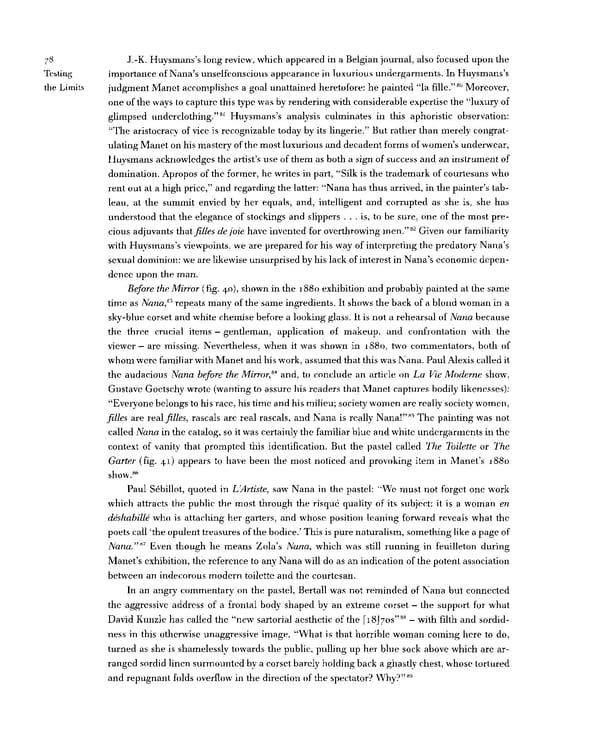8 J.-K. Huysmans's long review, which appeared in a Belgian journal, also focused upon the 7 Testing importance of Nana's unselfconscious appearance in luxurious undergarments. In Huysmans's the Limits 80 judgment Manet accomplishes a goal unattained heretofore: he painted "la fille." Moreover, one of the ways to capture this type was by rendering with considerable expertise the "luxury of glimpsed underclothing."81 Huysmans's analysis culminates in this aphoristic observation: "The aristocracy of vice is recognizable today by its lingerie." But rather than merely congrat- ulating Manet on his mastery of the most luxurious and decadent forms of women's underwear, Huysmans acknowledges the artist's use of them as both a sign of success and an instrument of domination. Apropos of the former, he writes in part, "Silk is the trademark of courtesans who rent out at a high price," and regarding the latter: "Nana has thus arrived, in the painter's tab- leau, at the summit envied by her equals, and, intelligent and corrupted as she is, she has understood that the elegance of stockings and slippers ... is, to be sure, one of the most pre- 82 cious adjuvants thatfilles de joie have invented for overthrowing men." Given our familiarity with Huysmans's viewpoints, we are prepared for his way of interpreting the predatory Nana's sexual dominion: we are likewise unsurprised by his lack of interest in Nana's economic depen- dence upon the man. Before the Mirror (fig. 40), shown in the 1880 exhibition and probably painted at the same time as Nana^ repeats many of the same ingredients. It shows the back of a blond woman in a sky-blue corset and white chemise before a looking glass. It is not a rehearsal of Nana because the three crucial items — gentleman, application of makeup, and confrontation with the viewer — are missing. Nevertheless, when it was shown in 1880, two commentators, both of whom were familiar with Manet and his work, assumed that this was Nana. Paul Alexis called it the audacious Nana before the Mirror** and, to conclude an article on La Vie Moderne show, Gustave Goetschy wrote (wanting to assure his readers that Manet captures bodily likenesses): "Everyone belongs to his race, his time and his milieu; society women are really society women, 85 filles are reaifilles, rascals are real rascals, and Nana is really Nana!" The painting was not called Nana in the catalog, so it was certainly the familiar blue and white undergarments in the context of vanity that prompted this identification. But the pastel called The Toilette or The Garter (fig. 41) appears to have been the most noticed and provoking item in Manet's 1880 show.86 Paul Sebillot, quoted in L'Artiste, saw Nana in the pastel: "We must not forget one work which attracts the public the most through the risque quality of its subject: it is a woman en deshabille who is attaching her garters, and whose position leaning forward reveals what the poets call 'the opulent treasures of the bodice.' This is pure naturalism, something like a page of 87 Nana." Even though he means Zola's Nana, which was still running in feuilleton during Manet's exhibition, the reference to any Nana will do as an indication of the potent association between an indecorous modern toilette and the courtesan. In an angry commentary on the pastel, Bertall was not reminded of Nana but connected the aggressive address of a frontal body shaped by an extreme corset — the support for what 88 David Kunzle has called the "new sartorial aesthetic of the [iSJ/os" - with filth and sordid- ness in this otherwise unaggressive image. "What is that horrible woman coming here to do, turned as she is shamelessly towards the public, pulling up her blue sock above which are ar- ranged sordid linen surmounted by a corset barely holding back a ghastly chest, whose tortured and repugnant folds overflow in the direction of the spectator? Why?"89
 Prostitution & Impressionists Page 98 Page 100
Prostitution & Impressionists Page 98 Page 100